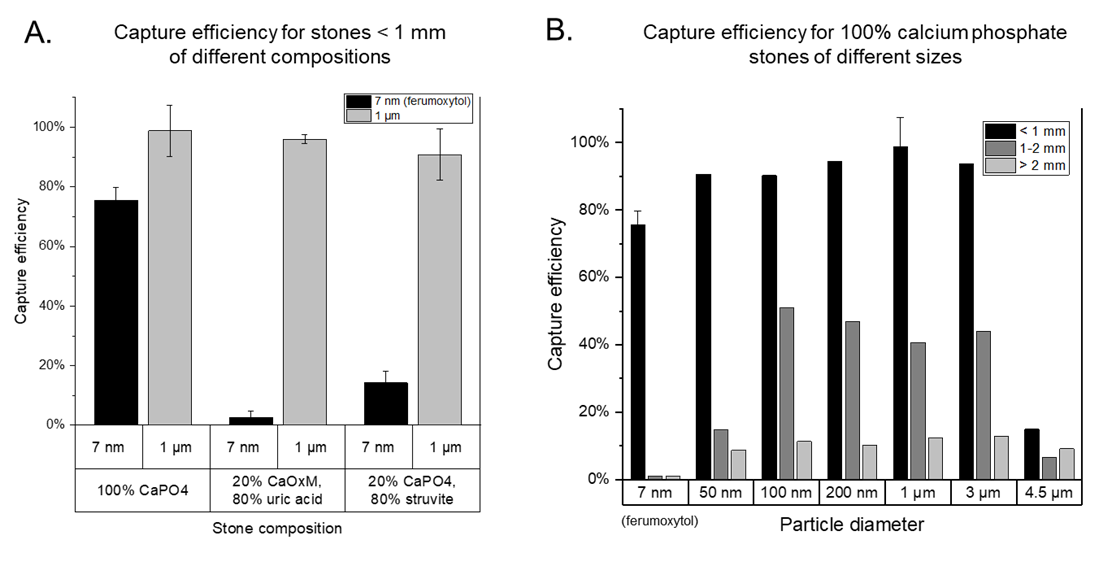Back
Poster, Podium & Video Sessions
Moderated Poster
MP14: Stone Disease: Surgical Therapy (including ESWL) I
MP14-19: Magnetic clearance of kidney stone fragments: initial in vitro experience
Friday, May 13, 2022
2:45 PM – 4:00 PM
Location: Room 225
Tianjia Jessie Ge*, Timothy Chang, Kathy Mach, Shan Wang, Kunj Sheth, Simon Conti, Joseph Liao, Palo Alto, CA

Tianjia Jessie Ge, MD
Stanford Urology
Poster Presenter(s)
Introduction: Surgical management of stone disease aims for complete clearance. Residual stone fragments are associated with more complications, yet only 60-75% of ureteroscopic treatments achieve complete stone-free status. While residual fragments < 2 mm in size are commonly deemed insignificant, up to 30% patients with “clinically insignificant fragments” experience stone-related complications. We propose a system to improve stone-free rates and surgical efficiency, in which fragments are rendered superparamagnetic and retrieved en masse with a magnetic guidewire.
Methods: Human kidney stone fragments obtained from lithotripsy (calcium phosphate (CaPO4), calcium oxalate monohydrate (CaOxM), uric acid, and struvite) were separated by size. Fragments (10-15 mg by dry weight) were rehydrated with normal saline and incubated with superparamagnetic iron oxide particles (range 7 nm to 4.5 µm diameter) possessing carboxylic acid surface chemistry for 3 minutes at 37C. A magnetic guidewire was fabricated from individual magnets within a plastic sheath (0.75 mm total diameter) and captured magnetically labeled fragments along its length in vitro. The fragments were dried and weighed to determine the capture efficiency. The speed of fragment retrieval was compared between the magnetic system and a conventional basket.
Results: The magnetic system cleared small fragments ( < 1 mm) up to twenty times faster than a standard basket in our in vitro experiments. The 7 nm nanoparticle, ferumoxytol, is FDA-approved for the treatment of iron deficiency anemia, and performed satisfactorily in capturing small calcium phosphate fragments. Larger 1 micron particles performed more consistently across different stone compositions. Capture efficiency decreases with increasing stone fragment size, owing to larger gravitational forces counteracting the magnetic attraction.
Conclusions: Iron oxide particles with carboxylic acid surface chemistries, including an FDA-approved nanoparticle, bind to a variety of calcium-based kidney stones. This approach can facilitate the efficient magnetic retrieval of small stone fragments which are difficult to basket, and lead to improved stone-free rates. Further optimization of particle chemistry and magnetic forces will allow for capture of larger fragments and clinical translation.
Source of Funding: Stanford Coulter Translational Grant, NIH R21 DK131776

Methods: Human kidney stone fragments obtained from lithotripsy (calcium phosphate (CaPO4), calcium oxalate monohydrate (CaOxM), uric acid, and struvite) were separated by size. Fragments (10-15 mg by dry weight) were rehydrated with normal saline and incubated with superparamagnetic iron oxide particles (range 7 nm to 4.5 µm diameter) possessing carboxylic acid surface chemistry for 3 minutes at 37C. A magnetic guidewire was fabricated from individual magnets within a plastic sheath (0.75 mm total diameter) and captured magnetically labeled fragments along its length in vitro. The fragments were dried and weighed to determine the capture efficiency. The speed of fragment retrieval was compared between the magnetic system and a conventional basket.
Results: The magnetic system cleared small fragments ( < 1 mm) up to twenty times faster than a standard basket in our in vitro experiments. The 7 nm nanoparticle, ferumoxytol, is FDA-approved for the treatment of iron deficiency anemia, and performed satisfactorily in capturing small calcium phosphate fragments. Larger 1 micron particles performed more consistently across different stone compositions. Capture efficiency decreases with increasing stone fragment size, owing to larger gravitational forces counteracting the magnetic attraction.
Conclusions: Iron oxide particles with carboxylic acid surface chemistries, including an FDA-approved nanoparticle, bind to a variety of calcium-based kidney stones. This approach can facilitate the efficient magnetic retrieval of small stone fragments which are difficult to basket, and lead to improved stone-free rates. Further optimization of particle chemistry and magnetic forces will allow for capture of larger fragments and clinical translation.
Source of Funding: Stanford Coulter Translational Grant, NIH R21 DK131776


.jpg)
.jpg)